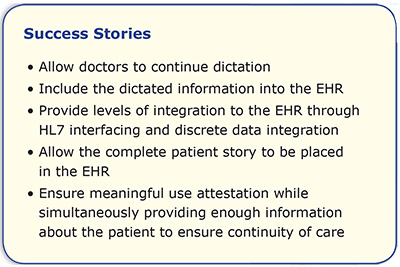With the passage of the HTECH Act and with the AARA funding initiative in full swing, many healthcare facilities and physician practices have been pressured to achieve "Meaningful Use" attestation by implementing an Electronic Health Record (EHR) solution. Although extremely beneficial to the advancement of clinical decision making, these solutions are often implemented with the primary focus of eliminating costs associated with conventional dictation/ transcription. Although well intentioned as a cost-saving measure to offset the expense of this new technology, these EHR solutions are creating unwanted outcomes and forcing workflow changes on the physician that adversely impact the efficiency of the main component of the revenue cycle process - the healthcare provider.
According to research published by MedScape News Today, EHR’s cost an average doctor 48 minutes per day that they could otherwise be spending with patients. Other studies show that it takes a physician an average of 4.5 minutes per patient to document a visit using templates in an EMR system. By contrast, dictation takes only 1.5 minutes per patient. Resulting in the doctor having to accept one of two outcomes: either see fewer patients, or work longer hours. Transcription costs may be lower, but so is productivity, resulting in thousands of dollars in lost revenue.
Accuracy of Data
While the above issue costs facilities thousands of dollars in lost billing, it is only one of several issues related to costly inefficiencies that stem from having doctors input data directly into EHR platforms. Potentially, the most serious issue concerning doctors directly entering data into
an EHR platform has to do with the accuracy of data. Faced with loss of productivity, healthcare providers are directly inputting patient data into EHR systems in a rushed environment, and there is no mechanism for checking the data. Medical facilities attempting to implement their EHR solution in this way have reported significant increases in danger- ous errors including incorrect drug names, dosages, inconsistent findings, and left-side, right-side issues. Not only are these errors dangerous to patients, creating potential liability issues for the facility, but they also increase system administration. In a traditional sense, dictated and then transcribed reports are subjected to closer scrutiny and quality controls primarily because clinical documentation specialists and the companies they work for have strict quality control procedures in place, and the provider prior to authentication and the report being available for patient care.
Faced with loss of productivity, healthcare providers are directly inputting patient data into EHR systems in a rushed environment

Training
Many facilities have reported significant issues related to training doctors to use an EHR platform. First, as with any new technology, learning to effectively use an EHR platform takes a number of hours. Second, as doctors work different shifts it is difficult to orchestrate training sessions with a number of staff members at the same time, as such, it can take months to actually conduct sessions with every doctor at a facility. It's even more difficult if multiple facilities share doctors. One facility we recently spoke with told us that they still did not have everyone trained more than 90 days after starting the training process. Making matters worse, many facilities have reported that they had older or less technically savvy doctors refuse to learn the new system.
Combating negative EHR consequences

Physicians and medical facilities can combat the negative EHR consequences that adversely impact physician efficiency and data integrity. More and more evidence is being supported through case studies of medical facilities experiencing the most successful implementations of EHR platforms. Most often, these success stories are based on allowing physicians to continue the dictation process and including the information from the dictated narrative in the EHR.
This can be accomplished by companies such as Med-Scribe that specialize in improving clinical documentation efficiency and integrity. By providing levels of integration to the EHR through HL7 interfacing and discrete data integration, Med-Scribe allows the complete patient story to be placed in the EHR to ensure meaningful use attestation while simultaneously providing enough information about the patient encounter to ensure continuity of care downstream resulting in better patient care for everyone.



